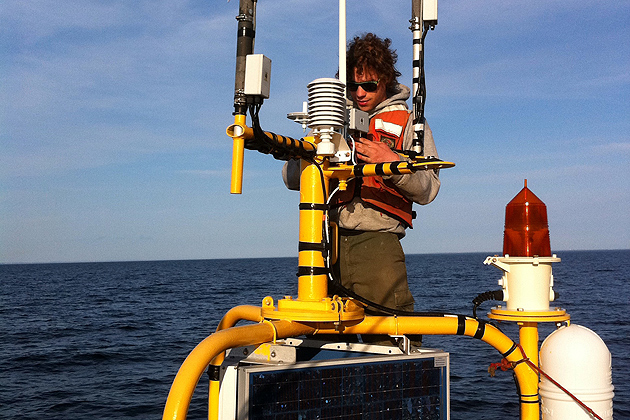
A Northeast ocean-monitoring network, including the University of Connecticut’s marine sciences department, has been awarded $1.77 million from the National Oceanic and Atmospheric Administration over the next year, and similar funding for the next four years. The grant will preserve remote sensing tracking of essential sea and atmospheric data for weather forecasting, fishermen, commercial shippers, and scientists.
“Among other things, this network is routinely used for the national weather forecasting service,” says marine sciences professor Jim O’Donnell, who works as chair of the network’s strategic planning committee. “This is what provides weather on the TV news every night.”
UConn’s marine sciences department is a major player in the network, called the Northeastern Regional Association of Coastal Ocean Observing Systems (NERACOOS), providing faculty expertise and developing equipment used in Long Island Sound and along the East Coast.
This year marks the 10th anniversary of UConn’s system of buoys, which are deployed throughout Long Island Sound to measure such things as wind speed, currents, dissolved oxygen, and nutrient content of water.
For the last three years, these buoys have been integrated into NERACOOS, whose monitoring extends from Connecticut through the coast of Maine and into Nova Scotia.

In addition to providing weather data to NERACOOS, UConn’s buoys are constantly testing water pollution levels. Sewage treatment plants throughout Connecticut have been undergoing upgrades over the past year in an effort to help clean degraded water in the Sound, and these buoys are essential to that effort, says O’Donnell.
“The data from the buoys is demonstrating that although sewage treatment plants are being upgraded, it’s not solving the problem,” says O’Donnell. “It’s not clear whether it’s working as we expected.” These data can help scientists hone their research to figure out what more can be done to restore the Sound.
And the buoys create great opportunities for students and faculty in marine sciences. They’re used widely for research in the department, and students visit the buoys and learn to use their data in hands-on classes and laboratories.
O’Donnell says state and federal representatives have been key to building and sustaining the system, adding, “Both the University and the state, especially DEEP, have been integral to investing in our work and making it a priority within NERACOOS.”



